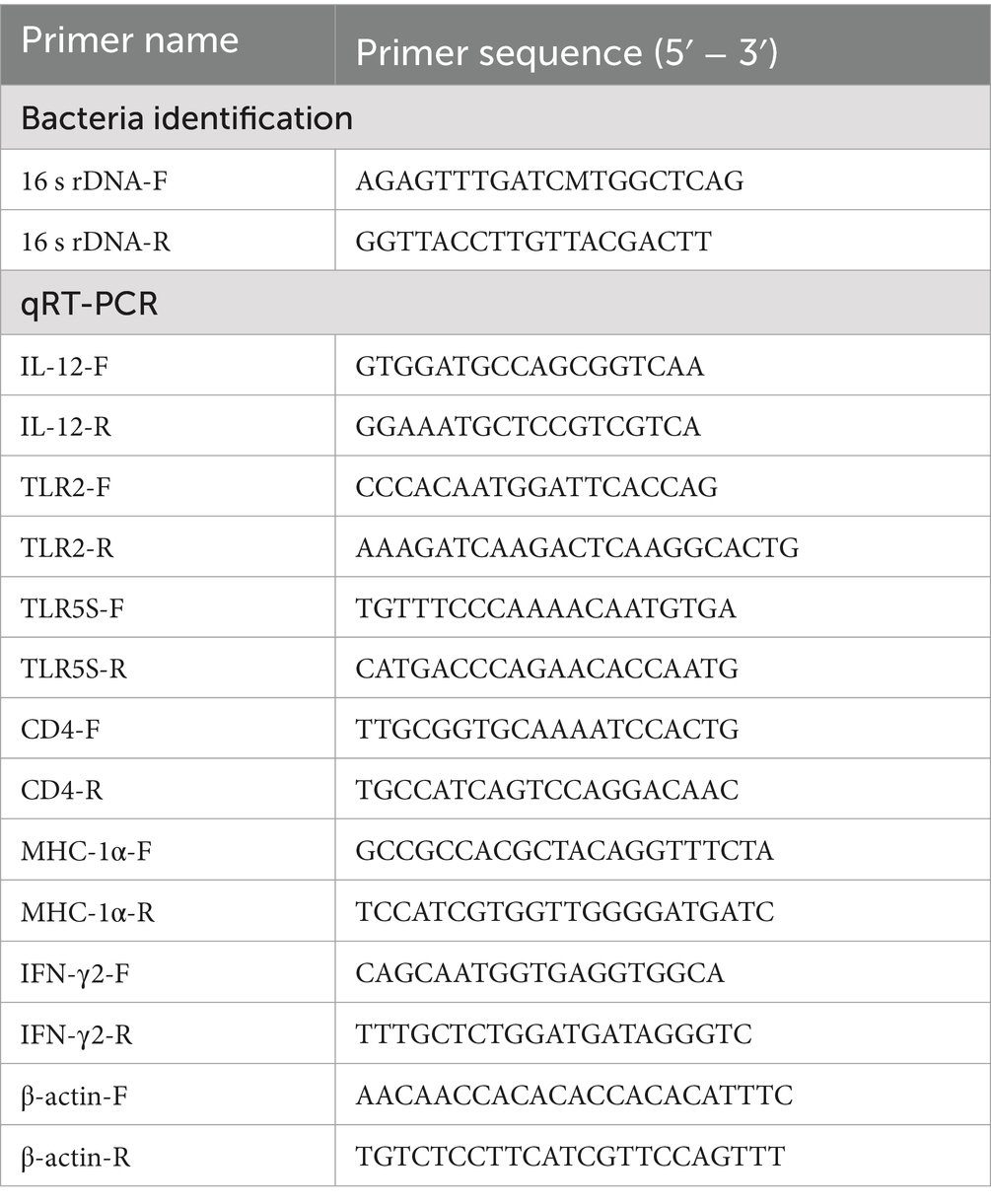- 1Guangdong Provincial Key Laboratory of Aquatic Animal Disease Control and Healthy Culture and Key Laboratory of Control for Disease of Aquatic Animals of Guangdong Higher Education Institute, College of Fishery, Guangdong Ocean University, Zhanjiang, China
- 2Guangdong Provincial Engineering Research Center for Aquatic Animal Health Assessment and Shenzhen Public Service Platform for Evaluation of Marine Economic Animal Seedings, Shenzhen Institute of Guangdong Ocean University, Shenzhen, China
Magnolia officinalis (MO) is a kind of traditional Chinese herbs, which has been studied for thousands of years in Chinese pharmacopoeia. In recent years, MO has been reported as an antibacterial agent in aquaculture, but the antibacterial properties of MO against Vibrio harveyi infection in fish remains unexplored. In this study, the effects of MO treatment on immune responses and the resistance to V. harveyi infection were detected in pearl gentian groupers. The results revealed that the expression levels of immune-related genes (IL-12, TLR2, TLR5S, CD4, MHC-Iα, and IFN-γ) in spleen, head kidney, liver and thymus, and the enzyme activities of CAT, SOD, LZM, and total serum protein in serum were significantly up-regulated at most of time points in MO -treated groupers. After being challenged with V. harveyi ZJ0603 at 28 days post-injection, the survival rate (SR) of groupers were 50.0, 60.0, 73.3, and 66.7% in MO groups at different concentrations, respectively, indicating that MO administration could improve the resistance to V. harveyi infection in groupers. The present study revealed that MO can be considered as a promising immunostimulant to induce the immune responses against V. harveyi infection in marine fishes.
1 Introduction
Infectious diseases caused by Vibrio spp. pose a serious threat to the health of humans and animals, and several species of Vibrio are known to cause illnesses in marine animals, including marine fishes, crabs, and shrimps (1). Vibrio harveyi is considered as a severe pathogen affecting a large number species of marine fishes, and it is known to induce gastroenteritis, necrotizing enteritis, nodules on the operculum, scale drop and muscle necrosis, skin ulcers, and tail rot in different species of fish (2). Predominantly cultured in tropical and subtropical regions, the pearl gentian grouper (E. fuscoguttatus × E. lanceolatus) is an important economic species of marine fishes. Nonetheless, grouper aquaculture has been devastated by multiple bacterial diseases, one of which is caused by V. harveyi infection (3). Several studies shown that infection of Vibrio diseases caused by V. harveyi, Vibrio vulnificus, and Vibrio alginolyticus, et al., resulted in serious economic losses in aquaculture industry of pearl gentian grouper (4). Therefore, it is very necessary to find a way to resist Vibrio disease of groupers. Antibiotics are widely used to combat these diseases, but their use has led to the rise of antibiotic resistance and food safety concerns (5, 6).
Chinese herbal medicine is a natural drug derived from plants, animals or minerals in nature, processed by traditional Chinese medicine theory and used for the prevention and treatment of diseases. In grouper fish farming industry, several Chinese herbal medicine or extract were used for disease prevention and improving the survival rates, such as Astragalus membranaceus, Spatholobus suberectus, Phellodendron amurense, Eclipta prostrata, Ganoderma lucidum polysaccharides, et al. (4, 7–9).
Known as “Hou po” in Chinese, Magnolia officinalis is a kind of Chinese herbal medicine that has been widely used in Asia for about 2000 years (10). Functionally, M. officinalis exerts a wide range of pharmacological effects on different organs/tissues in mammals (10). A large number of components have been found in M. officinalis, and honokiol (3,3′-diallyl-2,2′-dihydroxybiphenyl) and magnolol (5,5′-diallyl-2,2′-dihydroxybiphenyl) are identified as two important active components known for their cooperative antioxidant properties (11). Importantly, it is revealed that M. officinalis or its active components (magnolol and honokiol) not only have powerful directly antiviral (12–14), antibacterial (15–18), antiparasitic (19, 20), and antifungal (21) activities, also effectively improve immunity in different fish species, such as Ctenopharyngodon idella (12), Carassius auratus (15), Micropterus Salmoides (16), et al. However, the antibacterial properties of MO against V. harveyi infection remains unexplored in fish (22).
In this study, we aim to explore whether MO can be used as an effective immunostimulant against Vibrio spp. infection in fish. In the present study, the protective efficacy of MO against V. harveyi infection was evaluated in pearl gentian groupers. The immune-related genes including IL-12, TLR2, TLR5S, CD4, MHC-Iα, and IFN-γ, were tested in immune organs (spleen, head kidney, liver and thymus), and the enzyme activities of CAT, SOD, LZM, and total serum protein were also detected in serum. The findings indicated that MO represent a promising immunostimulant to induce the immune responses against V. harveyi infection in groupers, and a therapeutic agent to control Vibriosis in aquaculture.
2 Materials and methods
2.1 Bacterial strains and fish
Vibrio harveyi ZJ0603 was isolated from diseased grouper in Guangdong, China and stored in our laboratory, and was cultured in tryptic soy broth (TSB) in 28°C for the following experiment. The pearl gentian groupers, weighing 50.0 ± 5.0 g, were purchased from Donghai Island Fish Farm in Zhanjiang. These fish were kept in an oxygenated seawater tank and were fed twice daily. The animal study was reviewed and approved by Guangdong Provincial Key Laboratory of Pathogenic Biology and Epidemiology for Aquatic Economic Animals Ethics Committee (GDOU2023006).
2.2 MO preparation and fish treatment
Magnolia officinalis extract was purchased from Shanxi Yijunjian Biotech Co., LTD. MO extract was dissolved in 0.85% normal saline, and the solution was then filtered through the millipore membrane (0.45 mm) at adjusted concentrations of 2, 4, 6, and 8 mg/mL. A total of 450 fish were randomly divided into PBS, MO2, MO4, MO6, and MO8 groups, with 90 fish in each group. Fish were intraperitoneally injected with 100 μL of 2, 4, 6, and 8 mg/mL MO in MO2, MO4, MO6, and MO8 groups, respectively, while individuals was with 100 μL PBS in PBS group (control group). Spleen, head kidney, liver and thymus were collected at 2 and 4 w, and blood was collected from 1 to 6 weeks post-treatment (3 fish per group in per time point). The blood was stored overnight at 4°C and was centrifuged at 3500 rpm for 30 min to collect serum. Serum, spleen, head kidney, liver and thymus were stored at −80°C until further use.
2.3 Survival rate (SR) of MO-treated grouper after V. harveyi infection
Four weeks after injection, fish from PBS, MO2, MO4, MO6 and MO8 groups (90 fish per group) were intraperitoneally injected with 100 μL of V. harveyi ZJ0603 at a concentration of 5.01 × 106 CFU/mL (as used in this study). Subsequently, the fish was monitored for 14 days to calculate the SR using Kaplan–Meier method (23). To ensure that the fish were killed by V. harveyi, organs/tissues from randomly selected dead individuals were streaked on TCBS plates to identify the bacterial species. After 16S rDNA testing (Table 1), the PCR product was sent to Sangon Biotech to identify V. harveyi (Supplementary Figure 1).
2.4 Quantitative real-time PCR (qRT-PCR) analysis
Total RNA was extracted from organs/tissues by using the TransZol Up Plus RNA Kit, and was used for the cDNA synthesis by using Takara’s EasyScript® One-Step gDNA Removal and cDNA Synthesis SuperMix from China. qRT-PCR analysis was then conducted to detect the expression of well-studied immune-related genes, including IL-12, TLR2, TLR5S, CD4, MHC-Iα, and IFN-γ (24–29), with β-actin as the reference gene. The reaction condition of qRT-PCR was as follows: preincubation at 94°C for 300 s, 3-step amplification including 40 cycles of 94°C for 10s, 60°C for 15 s, and 72°C for 20s, with melting and cooling performed finally. The data were analyzed with the 2−ΔΔCt method as described in the previous studies (30, 31).
2.5 Enzyme activity and total serum protein (TP) in serum
The experimental measurements of catalase (CAT), lysozyme (LZM), superoxide dismutase (SOD), and total serum protein (TP) levels in serum were conducted by using a visible light-based hydrogen peroxide assay kit for catalase, a lysozyme assay kit, a superoxide dismutase assay kit, and a total protein quantification assay kit, respectively. All kits were sourced from the Nanjing Jiancheng Bioengineering Institute in China.
2.6 Statistical analysis
Data were statistics by one-way analysis of variance (ANOVA), followed by using SPSS 26.0 software with Duncan’s new multiple range test. Data were shown as mean ± SE, and significant differences (p < 0.05) are indicated by different letters (a–d). “n = 3” means three biological replicates.
3 Results
3.1 Protection of pearl gentian groupers from Vibrio harveyi infection by MO treatment
To detect the protective effect of MO in groupers against V. harveyi infection, the fish were monitored for 14 days to calculate the SR for all the groups. As shown in Figure 1, the SR of MO2, MO4, MO6, and MO8 groups were 50.0, 60.0, 73.3, and 66.7%, respectively, all of which were significantly higher than 26.7% in the PBS group (p < 0.05). These results showed that the treatment of MO facilitated the survival of fish after V. harveyi infection.
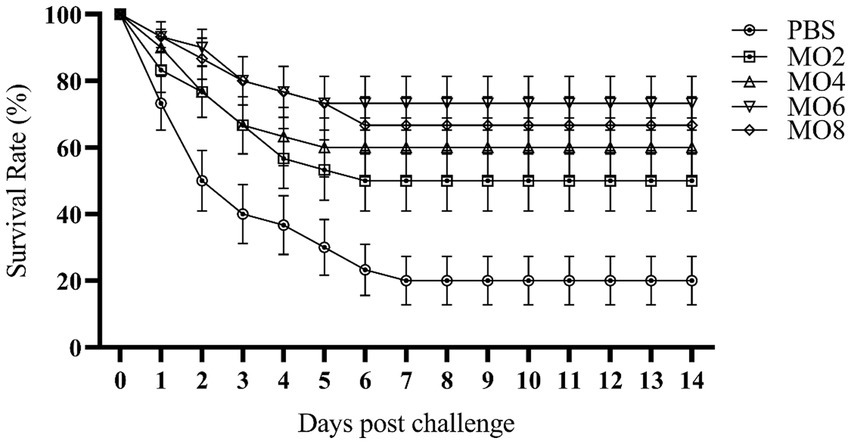
Figure 1. Survival rate of pearl gentian groupers challenged with V. harveyi for 14 days. Significant differences (p < 0.05) were obviously between the groups. Error bar represent mean ± SE.
3.2 Effect of MO treatment on the expression of immune-related genes in pearl gentian groupers
To assess the expression of immune-related genes in groupers after the treatment of different concentrations of MO, the transcriptional levels of IL-12, TLR2, TLR5S, CD4, MHC-Iα and IFN-γ were measured in spleen, head kidney, liver and thymus of groupers at 2 and 4 w post-treatment (Figures 2–5). The expression pattern of IL-12 was different in spleen, head kidney, liver, and thymus, and its expression was significantly up-regulated in spleen of MO2, MO4 and MO6 groups at 2 and 4 weeks, in head kidney of MO2 group for 2 and 4 weeks, in liver of MO4 and MO6 groups for both 2 weeks, and in thymus of MO4 group for both 2 weeks (Figures 2A, 3A, 4A, 5A). For TLR2, its expression was significantly up-regulated in head kidney and thymus of four groups for both 2 weeks, except MO8 group at the time-point of 4 weeks in thymus (Figures 3B, 5B). By contrast, the significant expression of TLR2 induced by MO both 2 weeks was only observed in liver of MO6 group, and spleen of MO6 and MO8 groups (Figures 2B, 4B). For TLR5S, its expression was significantly up-regulated in thymus of four groups, except MO2 group at the time-point of 4 w (Figure 5C). In spleen, liver and head kidney, the expression pattern of TLR5S was different, with no significant difference of most of groups (Figures 2C, 3C, 4C). For CD4, its expression in four groups was significantly up-regulated in spleen and liver, and head kidney at 4 w time-point, except MO4 group in head kidney (Figures 2D, 3D, 4D). In thymus, the expression pattern of CD4 was up-regulated of MO4, MO6, and MO8 groups for both 2 weeks (Figure 5D). For MHC-Iα, its expression was markedly induced in liver of four groups, and was differently regulated in other three organs/tissues (Figures 2E, 3E, 4E, 5E). Lastly, the expression of IFN-γ was significantly induced in four organs/tissues of MO6 and MO8 groups (Figures 2F, 3F, 4F, 5F).
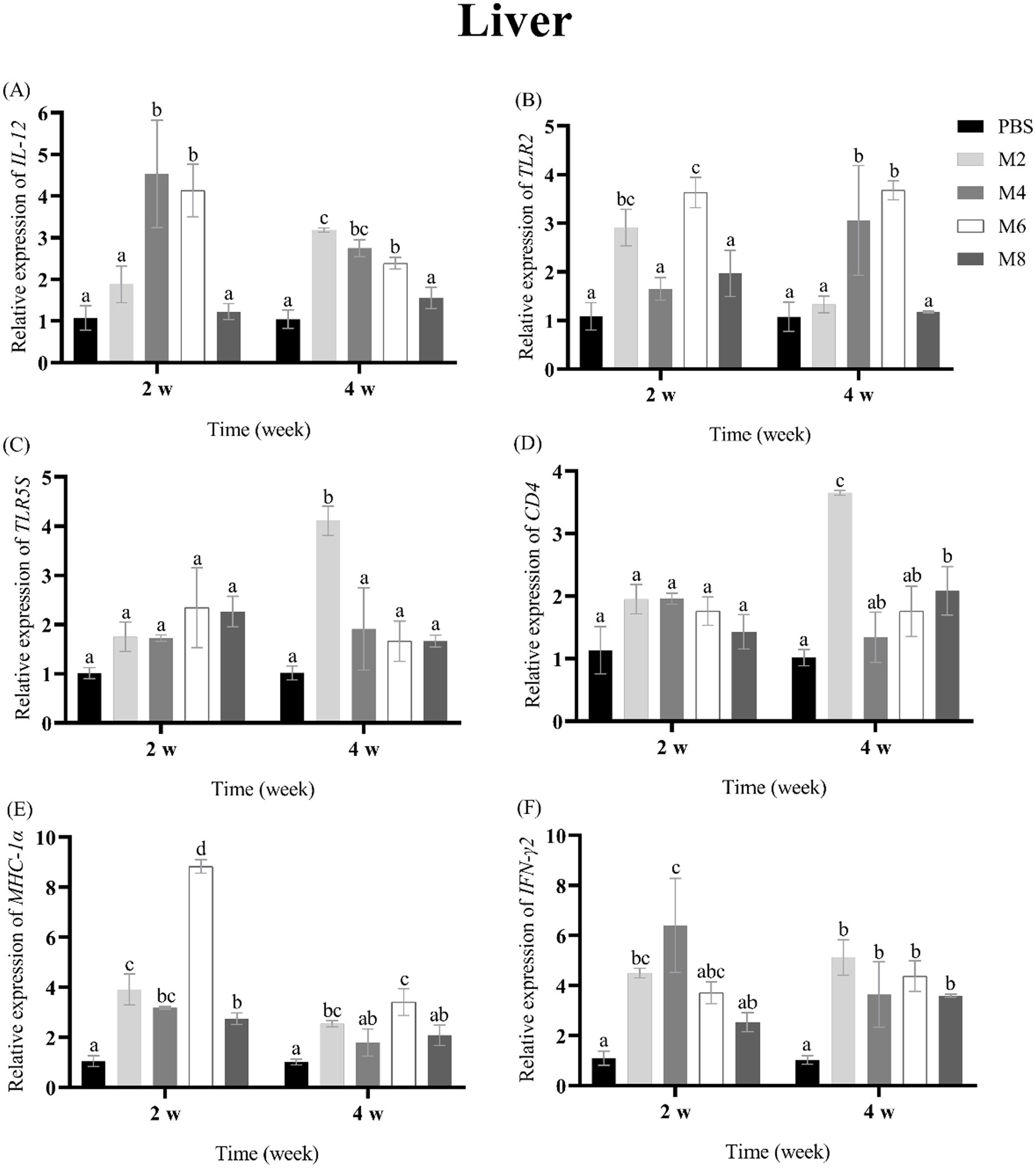
Figure 2. The expression levels of immune-related genes in the liver of pearl gentian groupers by qRT-PCR post-immunization. The mRNA level of each immune-related gene was normalized to that of β-actin and relative expression was calculated as the values of the vaccinated tissues by those of the controls. (A) IL-12, (B) TLR2, (C) TLR5, (D) CD4, (E) MHC-Iα, (F) IFN-γ. Bars represented the mean relative expression (n = 3). Significant differences (p < 0.05) are marked by different letters (a–d).
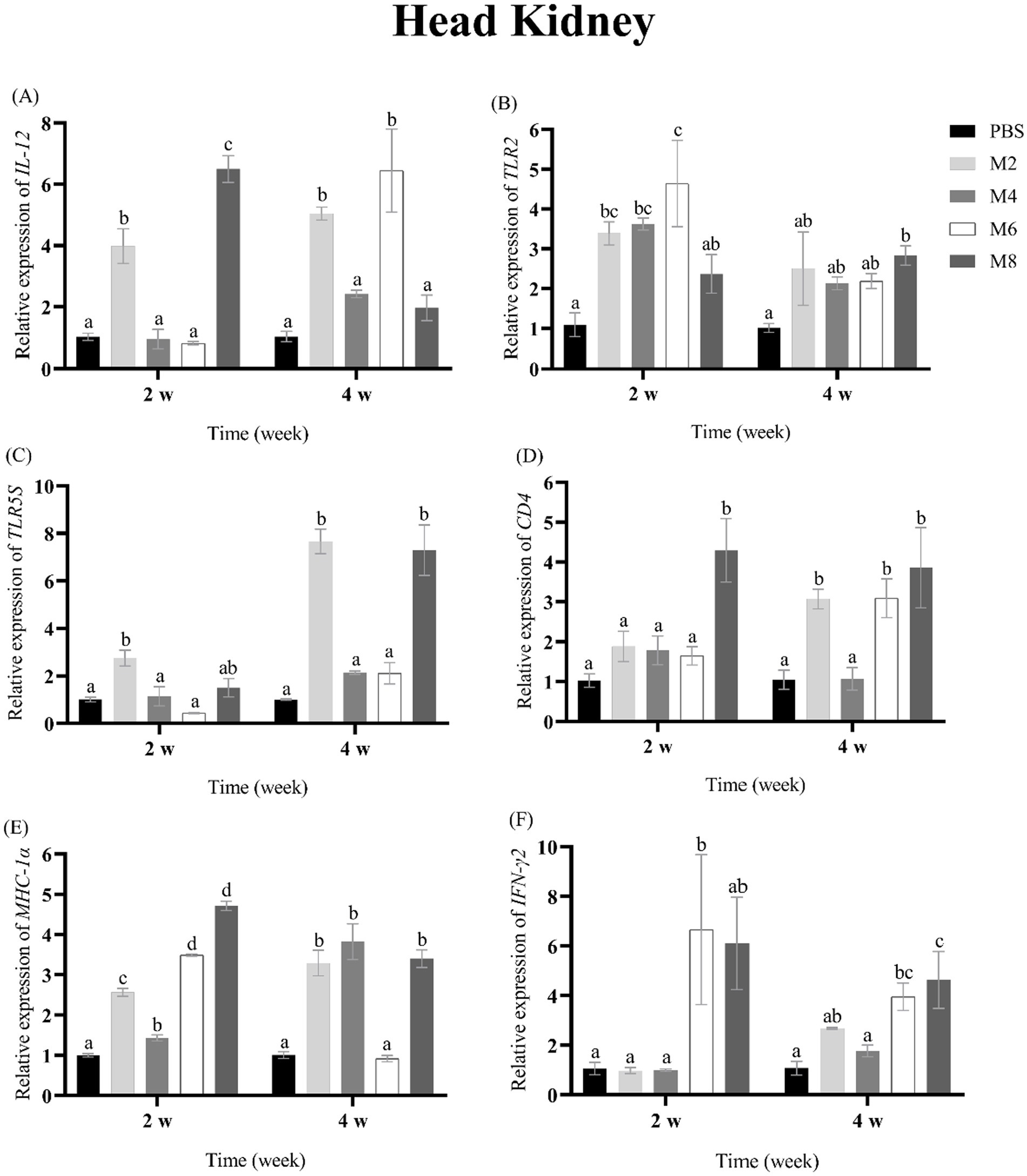
Figure 3. The expression levels of immune-related genes in the head kidney of pearl gentian groupers by qRT-PCR post-immunization. The mRNA level of each immune-related gene was normalized to that of β-actin and relative expression was calculated as the values of the vaccinated tissues by those of the controls. (A) IL-12, (B) TLR2, (C) TLR5, (D) CD4, (E) MHC-Iα, (F) IFN-γ. Bars represented the mean relative expression (n = 3). Significant differences (p < 0.05) are marked by different letters (a–d).
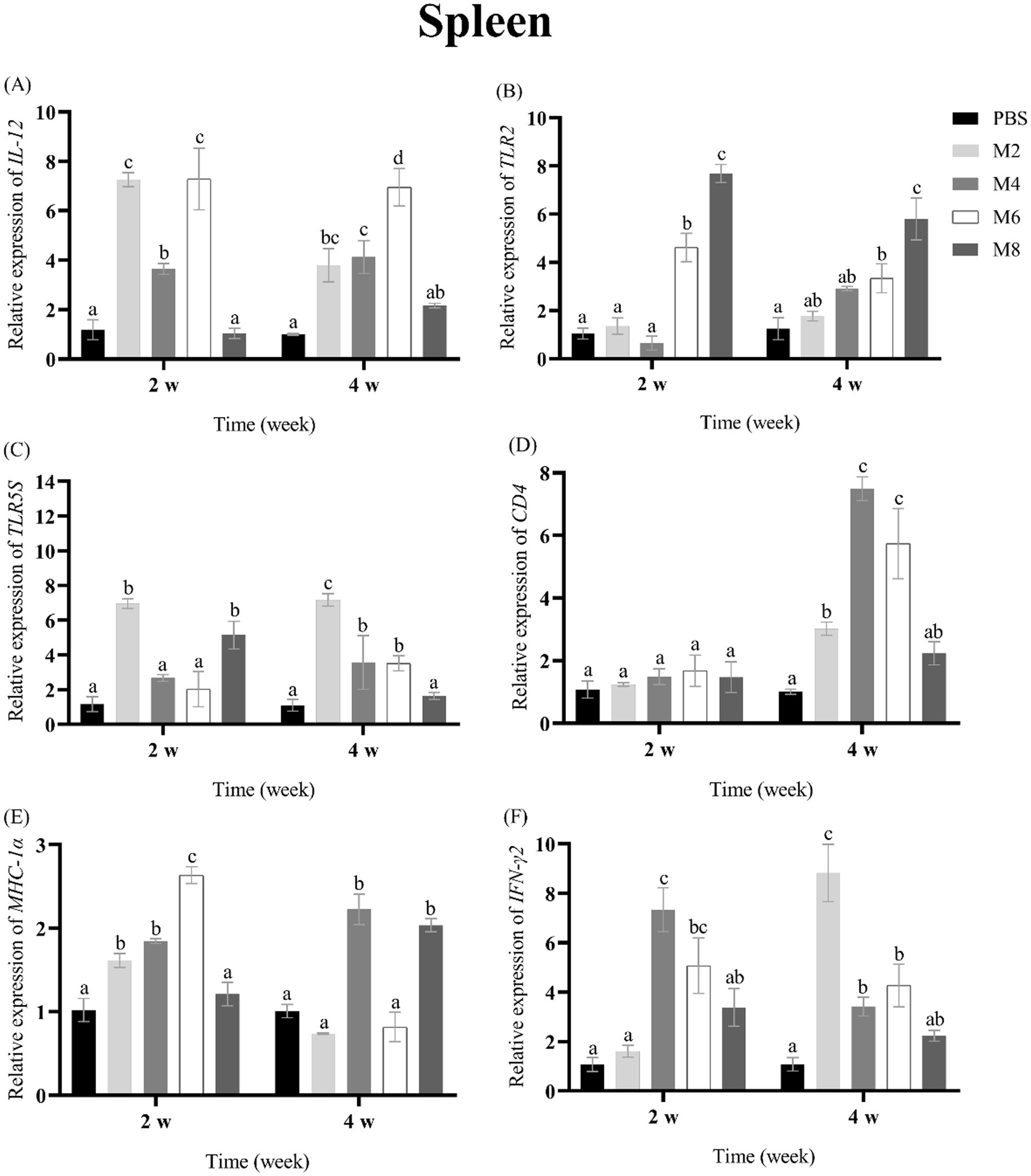
Figure 4. The expression levels of immune-related genes in the spleen of pearl gentian groupers by qRT-PCR post-immunization. The mRNA level of each immune-related gene was normalized to that of β-actin and relative expression was calculated as the values of the vaccinated tissues by those of the controls. (A) IL-12, (B) TLR2, (C) TLR5, (D) CD4, (E) MHC-Iα, (F) IFN-γ. Bars represented the mean relative expression (n = 3). Significant differences (p < 0.05) are marked by different letters (a–d).
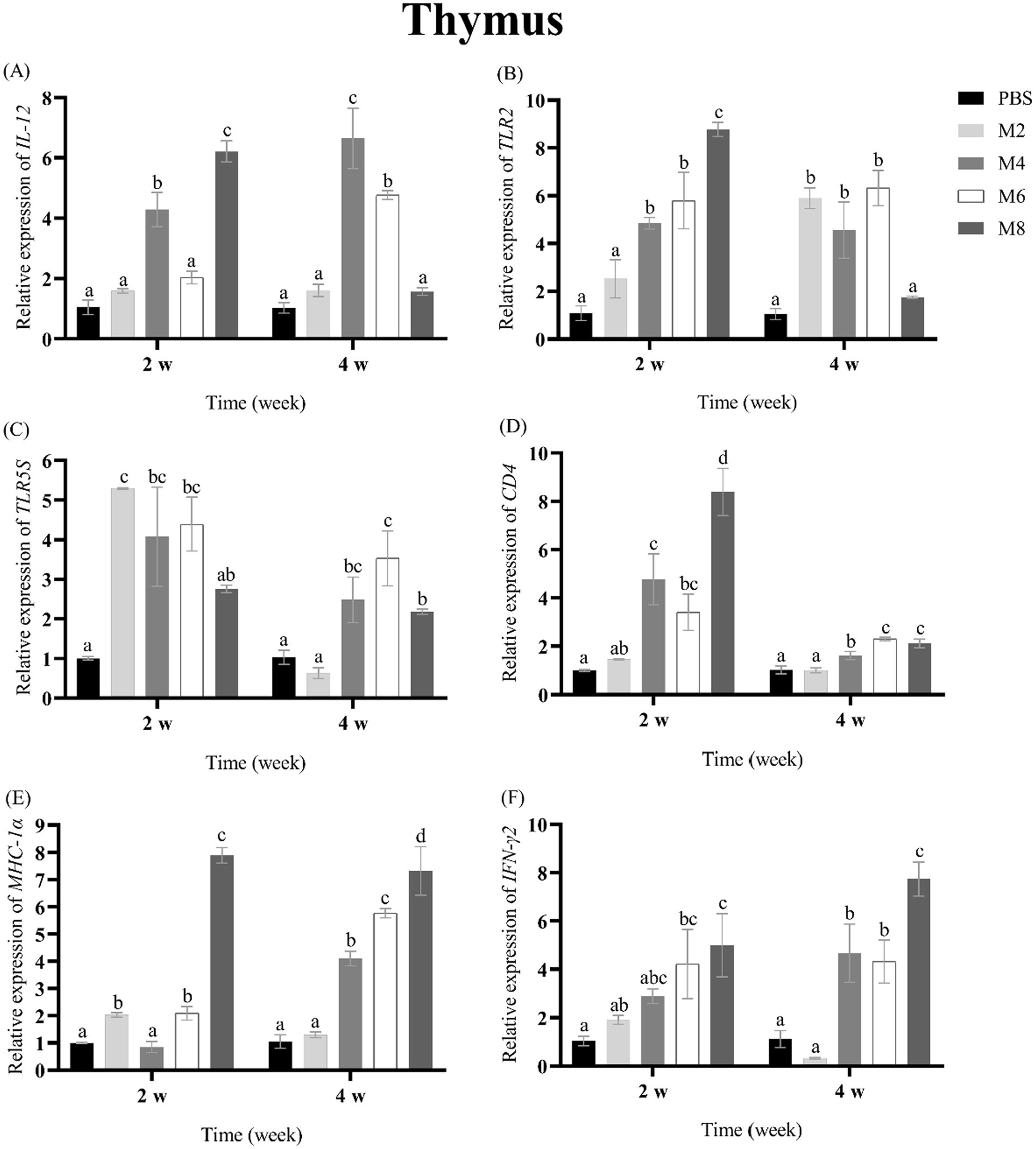
Figure 5. The expression levels of immune-related genes in the thymus of pearl gentian groupers by qRT-PCR post-immunization. The mRNA level of each immune-related gene was normalized to that of β-actin and relative expression was calculated as the values of the vaccinated tissues by those of the controls. (A) IL-12, (B) TLR2, (C) TLR5, (D) CD4, (E) MHC-Iα, (F) IFN-γ. Bars represented the mean relative expression (n = 3). Significant differences (p < 0.05) are marked by different letters (a–d).
3.3 Effect of MO treatment on CAT, LZM, SOD enzyme activity and total protein in serum of pearl gentian groupers
In MO8 group, the activities of CAT and LZM significantly increased at all time-points, while SOD activity and TP significantly increased only during the first 5 weeks (Figures 6A–D). By contrast, in all experimental groups, induced-expression of CAT, LZM, and SOD enzyme activity was observed for a long period of 6 weeks, and induced-expression of TP could only maintain until the fifth week.
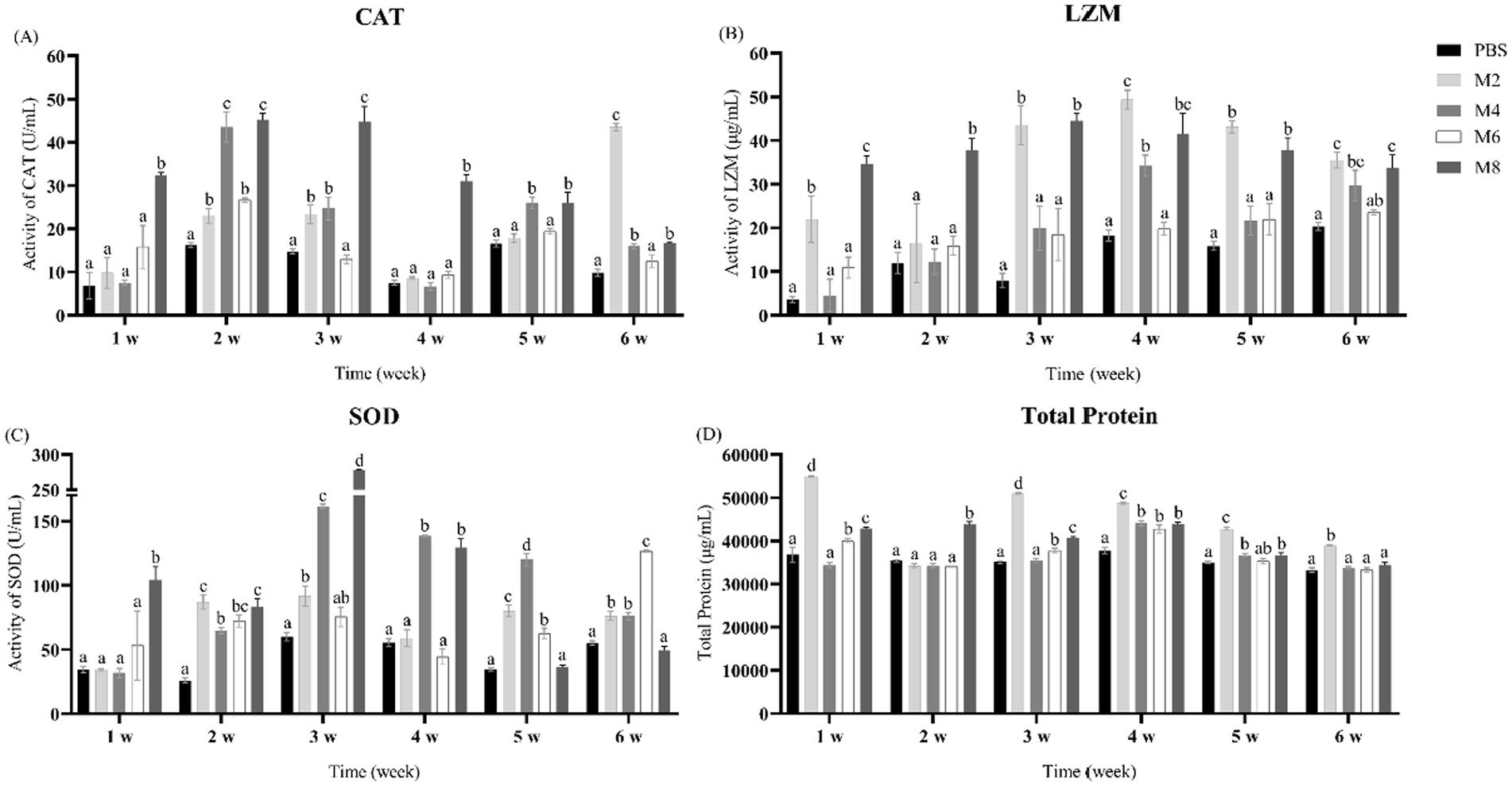
Figure 6. Catalase (CAT), lysozyme (LZM) and superoxide dismutase (SOD) activities and total serum protein of pearl gentian grouper from 1 to 6 w post-injection (mean ± SE; n = 3). (A) CAT activity, (B) LZM activity, (C) SOD activity, and (D) total serum protein. Significant differences (p < 0.05) are marked by different letters (a–d).
4 Discussion
Immunostimulants used to prevent disease in aquaculture has attracted much attention in recent years. Chinese herbal medicine or their active ingredients as one kind of immunostimulant play roles in enhancing disease resistance of fish by regulating the non-specific and specific immune response, which have been confirmed by multiple studies. Scutellaria baicalensis, A. membranaceus, Lycium barbarum and A. membranaceus polysaccharide were confirmed to enhance the SR after infected by gram-negative bacteria and innate immunity of fish (8, 32–34). Likewise, M. officinalis as one of traditional Chinese herbs, and its effective ingredients magnolol and honokiol have been shown to be effective in preventing Carassius auratus from Aeromonas hydrophila, A. veronii and Ichthyophthirius multififiliis infections (15, 19), channel catfish from A. hydrophila infection (35), and Micropterus Salmoides from Nocardia seriolae infection (16), by improving innate immunity index and SR. The molecular mechanism of MO is mainly manifested in anti-inflammatory and anti-bacterial effects. Firstly, magnolol and honokiol inhibit excessive inflammatory responses by targeting the TLR signaling pathway or directly binding to NF-κB, thereby suppressing the expression of inflammatory factors (36, 37). Secondly, the anti-bacterial activity achieved through multiple mechanisms, including destroying the cell wall, interfering with the function of the cell membrane, and inhibiting cell growth and reproduction, et al. (36, 37). In our research, we aimed to explore whether MO could significantly enhance the immunity and against bacterium infection of fish, which providing a new idea for the prevention and control of aquatic disease.
The recent surge in Vibriosis has hindered the development of the aquaculture industry, and it was critically important to develop a sustainable and healthy approach to combat Vibriosis (38, 39). It is reported the high efficacy of traditional Chinese herbs and their active ingredients in combating Vibriosis (18, 40). M. officinalis is one of the traditional Chinese herbs, and its effective ingredients magnolol and honokiol have been proven to improve immunity of the fish (15, 16, 19, 35) and have direct anti-bacterial effect (16, 36). However, the antibacterial properties of MO against V. harveyi infection remains unexplored in fish. In this study, our data revealed that the SR of groupers treated with MO at concentrations of 2, 4, 6, and 8 mg/mL was notably increased by 50.0, 60.0, 73.3, and 66.7%, respectively, compared to 26.7% in the control group, indicating that MO administration could enhanced the resistance of groupers to V. harveyi infection.
Fish immune responses are a multifaceted process that hinges on the collaboration of various components, including immune organs, cells, and molecules (41, 42). For immune organs, liver is an active site of lymphopoiesis primarily involved in innate immunity, inflammation, and homeostasis (41) and spleen is considered as an important peripheral lymphoid organ in fish (41, 43, 44). Head kidney is a crucial hematopoietic organ with regulatory functions and the center of immune-endocrine interactions (41, 45, 46), and thymus is responsible for the production of T cells and the stimulation of phagocytosis in teleost fish (41, 47, 48). To detect the immune response of groupers after MO injection, the expression of IL-12, TLR2, TLR5S, CD4, MHC-Iα, and IFN-γ in four tested organs. As a potent immunoregulatory cytokine, IL-12 can activate NK cells and promote macrophages to clear phagocytic pathogens, and enhance the resistance to bacteria, viruses, and parasites (25, 28). IFN-γ is a soluble cytokine produced by T cells, macrophages, mucosal epithelial cells, and natural killer cells, and it activates the JAK–STAT pathway, leading to the induction of genes involved in both innate and adaptive immune responses (49). MHC-Iα and MHC-IIα are primarily expressed on antigen-presenting cells and bind to CD8 and CD4 on cytotoxic T lymphocyte and helper T cells, respectively, to help distinguish between self and non-self antigens and initiate an appropriate immune response (27, 29, 50). In this study, the expression of IL-12, CD4, MHC-Iα and IFN-γ were up-regulated at most of time points in four immune-related organs, suggesting that the treatment of MO can induce immune responses of groupers. TLR2 and TLR5 are types of pattern recognition receptors (PRRs) for detecting various pathogen-associated molecular patterns (PAMPs) (51), and these two TLR molecules are mainly expressed on the surface of macrophages, dendritic cells, and other cells, and can activate the expression of inflammatory factors to resist pathogen invasion (24, 51, 52). Consistent with the result in the previous study (15), the expression of TLR2 and TLR5S was induced by MO treatment in immune organs of fish, suggesting that the treatment of MO can promote pathogen recognition in groupers.
Serum biochemistry tests are beneficial for evaluating the health status of fish and offer a perspective on assessing the safety of pharmaceuticals. SOD and CAT play a synergistic role in the cellular antioxidant defense system (53, 54). SOD converts superoxide anions to hydrogen peroxide, and CAT rapidly breaks down the hydrogen peroxide, both of which can effectively reduce the total amount of intracellular ROS (53, 54). Lysozyme can rupture gram-negative bacteria by facilitating the breakdown of β (1–4)-linked disaccharides in bacterial cell wall (55). Blood serum is composed of a multitude of elements that participate in immune reactions, such as globulins and albumin (56). Our data showed that the levels of SOD, CAT, LZM, and total protein in serum were significantly up-regulated by the stimulation of MO, indicating that MO treatment can facilitate antioxidant responses and health status in fish.
In this study, the upregulation of survival rate, immune-related factors (IL-12, TLR2, TLR5, CD4, MHC-Iα, IFN-γ), antioxidant enzymes (CAT, SOD), lysozyme (LZM), and total serum protein (TP) were observed in groupers after injection of MO extract, which revealed that injection of these concentrations of MO may cause a moderate immunomodulatory effect rather than a pathological hyperactivation. These results may stem from the multi-target regulatory effects of MO. Bioactive constituents (e.g., magnolol) of MO may gently stimulate TLR pathways for controlling release of the pro-inflammatory factor, and simultaneously enhancing antioxidant defenses (CAT, SOD) and the antimicrobial barrier (LZM) (12, 13, 15, 18). Therefore, the treatment of MO in grouper achieves an optimal balance between enhancing disease resistance and maintaining immune equilibrium. In future research, we will optimize the frequency and dosage of MO treatment, evaluating that injection of different concentrations of MO are ultimately harmful or beneficial to grouper during V. harveyi infection.
In conclusion, the impact of MO as immunostimulants on the pearl gentian grouper was assessed in this study. Our data revealed that administration of MO at doses of 2, 4, 6 or 8 mg/mL can significantly improve the expression of immune-related gene expression, the CAT, LZM, SOD enzyme activity and total protein in serum, and the resistance to V. harveyi infection in grouper, suggesting that MO can be considered as a promising immunostimulant against V. harveyi infection in fish. However, further systematic investigations are warranted to comprehensively validate the biosafety and translational potential of MO in aquaculture, including but not limited to dose optimization, long-term toxicity assessment, sample size increasing, immune-related protein level verification, histopathology, intestinal flora analysis, and microbiome-host crosstalk analysis.
Data availability statement
The original contributions presented in the study are included in the article/Supplementary material, further inquiries can be directed to the corresponding author/s.
Ethics statement
The animal study was approved by Guangdong Provincial Key Laboratory of Pathogenic Biology and Epidemiology for Aquatic Economic Animals Ethics Committee. The study was conducted in accordance with the local legislation and institutional requirements.
Author contributions
YZ: Conceptualization, Data curation, Investigation, Software, Writing – original draft. YuL: Investigation, Writing – original draft. XX: Investigation, Writing – original draft. LX: Investigation, Writing – original draft. WL: Investigation, Writing – original draft. ZG: Conceptualization, Funding acquisition, Project administration, Writing – review & editing. YiL: Conceptualization, Funding acquisition, Project administration, Supervision, Writing – review & editing.
Funding
The author(s) declare that financial support was received for the research and/or publication of this article. The present research was supported by the grant from the National Key Research and Development Project (2023YFD2401705), and also by the program for scientific research start-up funds of Guangdong Ocean University (060302422202).
Conflict of interest
The authors declare that the research was conducted in the absence of any commercial or financial relationships that could be construed as a potential conflict of interest.
Generative AI statement
The authors declare that no Gen AI was used in the creation of this manuscript.
Publisher’s note
All claims expressed in this article are solely those of the authors and do not necessarily represent those of their affiliated organizations, or those of the publisher, the editors and the reviewers. Any product that may be evaluated in this article, or claim that may be made by its manufacturer, is not guaranteed or endorsed by the publisher.
Supplementary material
The Supplementary material for this article can be found online at: https://www.frontiersin.org/articles/10.3389/fvets.2025.1603997/full#supplementary-material
References
1. Liu, S, Yang, D, Li, W, Chen, Q, Lu, D, Xiong, L, et al. Magnolia officinalis alcohol extract alleviates the intestinal injury induced by polygala tenuifolia through regulating the PI3K/AKT/NF-κB signaling pathway and intestinal flora. DDDT. (2024) 18:1695–710. doi: 10.2147/DDDT.S461152
2. Zhang, X-H, He, X, and Austin, B. Vibrio harveyi: a serious pathogen of fish and invertebrates in mariculture. Mar Life Sci Technol. (2020) 2:231–45. doi: 10.1007/s42995-020-00037-z
3. Guan, L, Li, X, Chen, J, Wang, L, Zhang, X, Sun, H, et al. Co-infection of nervous necrosis virus and Vibrio harveyi increased mortality and worsened the disease severity in the orange-spotted grouper (Epinephelus coioides). Fish Shellfish Immunol. (2025) 158:110117. doi: 10.1016/j.fsi.2025.110117
4. Zhang, Y, Zhong, J, Huang, Y, Jian, J, and Cai, S. 1 immune effect of Ganoderma lucidum polysaccharides as an immunostimulants against Vibrio harveyi in pearl gentian grouper (♀Epinephelus fuscoguttatus ×♂Epinephelus lanceolatus). Front Mar Sci. (2022) 9:968838. doi: 10.3389/fmars.2022.968838
5. Ferri, G, Lauteri, C, and Vergara, A. Antibiotic resistance in the finfish aquaculture industry: a review. Antibiotics (Basel). (2022) 11:1574. doi: 10.3390/antibiotics11111574
6. Holm, R, Söderhäll, K, and Söderhäll, I. Accumulation of antibiotics and antibiotic resistance genes in freshwater crayfish - effects of antibiotics as a pollutant. Fish Shellfish Immunol. (2023) 138:108836. doi: 10.1016/j.fsi.2023.108836
7. Cai, J, Yang, Z, Huang, Y, Jian, J, and Tang, J. Effects of Chinese herbal medicines on growth performance, intestinal flora, immunity and serum metabolites of hybrid grouper (Epinephelus fuscoguttatus♀×Epinephelus lanceolatu♂). Fish Shellfish Immunol. (2023) 140:108946. doi: 10.1016/j.fsi.2023.108946
8. Xia, Y-T, Wu, Q-Y, Cheng, H-CE, Dong, T-XT, Qin, Q-W, Wang, W-X, et al. The inclusion of extract from aerial part of Scutellaria baicalensis in feeding of pearl gentian grouper (Epinephelus fuscoguttatus♀ × Epinephelus lanceo-latus♂) promotes growth and immunity. Fish Shellfish Immunol. (2022) 127:521–9. doi: 10.1016/j.fsi.2022.06.041
9. Cai, Y, Wang, S, Guo, W, Xie, Z, Zheng, Y, Cao, Z, et al. Transcriptome analysis provides insights into the immune responsive pathways and genes in the head kidney of tiger grouper (Epinephelus fuscoguttatus) fed with Spatholobus suberectus, Phellodendron amurense, or Eclipta prostrata. Fish Shellfish Immunol. (2018) 73:100–11. doi: 10.1016/j.fsi.2017.12.004
10. Luo, H, Wu, H, Yu, X, Zhang, X, Lu, Y, Fan, J, et al. A review of the phytochemistry and pharmacological activities of Magnoliae officinalis cortex. J Ethnopharmacol. (2019) 236:412–42. doi: 10.1016/j.jep.2019.02.041
11. Lee, Y-J, Choi, D-Y, Yun, Y-P, Han, SB, Kim, HM, Lee, K, et al. Ethanol extract of Magnolia officinalis prevents lipopolysaccharide-induced memory deficiency via its antineuroinflammatory and antiamyloidogenic effects. Phytother Res. (2013) 27:438–47. doi: 10.1002/ptr.4740
12. Chen, X, Hu, Y, Shan, L, Yu, X, Hao, K, and Wang, G. Magnolol and honokiol from Magnolia officinalis enhanced antiviral immune responses against grass carp reovirus in Ctenopharyngodon idella kidney cells. Fish Shellfish Immunol. (2017) 63:245–54. doi: 10.1016/j.fsi.2017.02.020
13. Chen, X, Hao, K, Yu, X, Huang, A, Zhu, B, Wang, G, et al. Magnolol protects Ctenopharyngodon idella kidney cells from apoptosis induced by grass carp reovirus. Fish Shellfish Immunol. (2018) 74:426–35. doi: 10.1016/j.fsi.2017.12.035
14. Jin, Y, Yang, F, Zhang, G, Yu, Q, Wang, G, Ling, F, et al. Synthesized Magnolol derivatives improve anti-Micropterus salmoides Rhabdovirus (MSRV) activity in vivo. Viruses. (2022) 14:1421. doi: 10.3390/v14071421
15. Zhang, Z, Li, J, Wang, G, and Ling, F. The oral protective efficacy of magnolol against Aeromonas hydrophila and A. veronii infection via enhancing anti-inflammatory ability in goldfish (Carassius auratus). J Fish Dis. (2023) 46:1413–23. doi: 10.1111/jfd.13859
16. Jiang, X, Ren, Z, Zhang, N, Yang, K, Wang, G, and Jiang, H. Screening and evaluating honokiol from Magnolia officinalis against Nocardia seriolae infection in largemouth bass (Micropterus salmoides). J Fish Dis. (2022) 45:1599–607. doi: 10.1111/jfd.13683
17. Guo, Y, Xing, Z, He, Z, Zhao, X, and Ye, S. Honokiol inhibits Vibrio harveyi hemolysin virulence by reducing its haemolytic activity. Aquac Res. (2020) 51:206–14. doi: 10.1111/are.14366
18. Huang, H, Su, L, Sun, Y, Li, B, Deng, J, and Cao, Z. Dietary magnolol inclusion improves the antioxidant and immune responses, and resistance to Aeromonas hydrophila in genetically improved farmed tilapia (Oreochromis niloticus). Aquac Rep. (2022) 23:101017. doi: 10.1016/j.aqrep.2022.101017
19. Zhang, Z, Cui, H, Zhang, Z, Qu, S, Wang, G, and Ling, F. Pharmacokinetics of magnolol following different routes of administration to goldfish (Carassius auratus) and its oral efficacy against Ichthyophthirius multififiliis infection. Aquaculture. (2022) 546:737356. doi: 10.1016/j.aquaculture.2021.737356
20. Zhong, Z-H, Guo, W-L, Lei, Y, Wang, F, Wang, S-F, Sun, Y, et al. Antiparasitic efficacy of honokiol against Cryptocaryon irritans in pompano, Trachinotus ovatus. Aquaculture. (2019) 500:398–406. doi: 10.1016/j.aquaculture.2018.10.037
21. Xie, Y, Hua, H, and Zhou, P. Magnolol as a potent antifungal agent inhibits Candida albicans virulence factors via the PKC and Cek 1 MAPK signaling pathways. Front Cell Infect Microbiol. (2022) 12:935322. doi: 10.3389/fcimb.2022.935322
22. Zhang, W, Zhao, J, Ma, Y, Li, J, and Chen, X. The effective components of herbal medicines used for prevention and control of fish diseases. Fish Shellfish Immunol. (2022) 126:73–83. doi: 10.1016/j.fsi.2022.05.036
23. Guyot, P, Ades, AE, Ouwens, MJNM, and Welton, NJ. Enhanced secondary analysis of survival data: reconstructing the data from published Kaplan-Meier survival curves. BMC Med Res Methodol. (2012) 12:9. doi: 10.1186/1471-2288-12-9
24. Guo, S, Yang, Q, Fan, Y, Ran, M, Shi, Q, and Song, Z. Characterization and expression profiles of toll-like receptor genes (TLR2 and TLR5) in immune tissues of hybrid yellow catfish under bacterial infection. Fish Shellfish Immunol. (2024) 150:109627. doi: 10.1016/j.fsi.2024.109627
25. Jiang, X-X, Tang, Z-R, Li, Z-P, Zhang, G-R, Zhou, X, Ma, X-F, et al. Molecular characterization, expression analysis and function identification of Pf_IL-12p35, Pf_IL-23p19 and Pf_IL-12p40 genes in yellow catfish (Pelteobagrus fulvidraco). Fish Shellfish Immunol. (2024) 150:109623. doi: 10.1016/j.fsi.2024.109623
26. Pang, AN, Chen, SN, Gan, Z, Li, L, Li, N, Wang, S, et al. Identification of type II interferons and receptors in an osteoglossiform fish, the arapaima Arapaima gigas. Dev Comp Immunol. (2023) 139:104589. doi: 10.1016/j.dci.2022.104589
27. Tian, H, Xing, J, Tang, X, Sheng, X, Chi, H, and Zhan, W. Cytokine networks provide sufficient evidence for the differentiation of CD4+ T cells in teleost fish. Dev Comp Immunol. (2023) 141:104627. doi: 10.1016/j.dci.2022.104627
28. Gan, Z, Chen, SN, Huang, B, Zou, J, and Nie, P. Fish type I and type II interferons: composition, receptor usage, production and function. Rev Aquac. (2020) 12:773–804. doi: 10.1111/raq.12349
29. Xu, C, Xue, M, Jiang, N, Li, Y, Meng, Y, Liu, W, et al. Characteristics and expression profiles of MHC class I molecules in Carassius auratus. Fish Shellfish Immunol. (2023) 137:108794. doi: 10.1016/j.fsi.2023.108794
30. Gan, Z, Chen, SN, Huang, B, Hou, J, and Nie, P. Intronless and intron-containing type I IFN genes coexist in amphibian Xenopus tropicalis: insights into the origin and evolution of type I IFNs in vertebrates. Dev Comp Immunol. (2017) 67:166–76. doi: 10.1016/j.dci.2016.10.007
31. Tang, S, Zhang, M, Cai, J, Wen, Q, Mo, J, Long, M, et al. Identification and functional characterization of a long-type peptidoglycan recognition protein, PGRP-L in amphibian Xenopus laevis. Gene. (2024) 928:148770. doi: 10.1016/j.gene.2024.148770
32. Sun, F, Wu, Y, Zhang, Y, Liu, Q, Wang, Q, and Liu, X. An aluminium adjuvant compound with ginseng stem leaf saponins enhances the potency of inactivated Pseudomonas plecoglossicida vaccine in large yellow croaker (Larimichthys crocea). Fish Shellfish Immunol. (2024) 144:109243. doi: 10.1016/j.fsi.2023.109243
33. Wu, S. Dietary Astragalus membranaceus polysaccharide ameliorates the growth performance and innate immunity of juvenile crucian carp (Carassius auratus). Int J Biol Macromol. (2020) 149:877–81. doi: 10.1016/j.ijbiomac.2020.02.005
34. Mo, WY, Lun, CHI, Choi, WM, Man, YB, and Wong, MH. Enhancing growth and non-specific immunity of grass carp and Nile tilapia by incorporating Chinese herbs (Astragalus membranaceus and Lycium barbarum) into food waste based pellets. EP. (2016) 219:475–82. doi: 10.1016/j.envpol.2016.05.055
35. Dong, J, Ding, H, Liu, Y, Yang, Q, Xu, N, Yang, Y, et al. Magnolol protects channel catfish from Aeromonas hydrophila infection via inhibiting the expression of aerolysin. Vet Microbiol. (2017) 211:119–23. doi: 10.1016/j.vetmic.2017.10.005
36. Dai, X, Xie, L, Liu, K, Liang, Y, Cao, Y, Lu, J, et al. The neuropharmacological effects of Magnolol and Honokiol: a review of signal pathways and molecular mechanisms. Curr Mol Pharmacol. (2023) 16:161–77. doi: 10.2174/1874467215666220223141101
37. Dai, S-Y, Qin, W-X, Yu, S, Li, C, Yang, Y-H, and Pei, Y-H. Honokiol and magnolol: a review of structure-activity relationships of their derivatives. Phytochemistry. (2024) 223:114132. doi: 10.1016/j.phytochem.2024.114132
38. Li, Y, Lin, G, Pengsakul, T, Yan, Q, and Huang, L. Antibiotic resistance in Vibrio parahaemolyticus: mechanisms, dissemination, and global public health challenges—a comprehensive review. Rev Aquac. (2025) 17:e13010. doi: 10.1111/raq.13010
39. Vandeputte, M, Kashem, MA, Bossier, P, and Vanrompay, D. Vibrio pathogens and their toxins in aquaculture: a comprehensive review. Rev Aquac. (2024) 16:1858–78. doi: 10.1111/raq.12926
40. Zhang, Y, Tan, H, Wei, G, Huang, Y, Jian, J, and Cai, S. The effect of chitosan oligosaccharide as an immune enhancer against Vibrio harveyi in pearl gentian grouper (♀ Epinephelus fuscoguttatus × ♂ Epinephelus lanceolatus). Aquac Res. (2021) 52:541–6. doi: 10.1111/are.14912
41. Buchmann, K, Karami, AM, and Duan, Y. The early ontogenetic development of immune cells and organs in teleosts. Fish Shellfish Immunol. (2024) 146:109371. doi: 10.1016/j.fsi.2024.109371
42. Surachetpong, W, Roy, SRK, and Nicholson, P. Tilapia lake virus: the story so far. J Fish Dis. (2020) 43:1115–32. doi: 10.1111/jfd.13237
43. Sun, J, Ruiz Daniels, R, Balic, A, Andresen, AMS, Bjørgen, H, Dobie, R, et al. Cell atlas of the Atlantic salmon spleen reveals immune cell heterogeneity and cell-specific responses to bacterial infection. Fish Shellfish Immunol. (2024) 145:109358. doi: 10.1016/j.fsi.2024.109358
44. Zapata, AG. The fish spleen. Fish Shellfish Immunol. (2024) 144:109280. doi: 10.1016/j.fsi.2023.109280
45. Andresen, AMS, Taylor, RS, Grimholt, U, Daniels, RR, Sun, J, Dobie, R, et al. Mapping the cellular landscape of Atlantic salmon head kidney by single cell and single nucleus transcriptomics. Fish Shellfish Immunol. (2024) 146:109357. doi: 10.1016/j.fsi.2024.109357
46. Geven, EJW, and Klaren, PHM. The teleost head kidney: integrating thyroid and immune signalling. Dev Comp Immunol. (2017) 66:73–83. doi: 10.1016/j.dci.2016.06.025
47. Bjørgen, H, Barac, F, Fjelldal, PG, Hansen, T, Hordvik, I, and Koppang, EO. Organisation of the Atlantic salmon (Salmo salar) thymus and its content of Ig-expressing cells. Fish Shellfish Immunol. (2024) 150:109652. doi: 10.1016/j.fsi.2024.109652
48. Hasan, A, Macias, JJ, Wood, B, Malone-Perez, M, Park, G, Foster, CA, et al. Dynamic changes in lymphocyte populations establish zebrafish as a thymic involution model. J Immunol. (2024) 212:1733–43. doi: 10.4049/jimmunol.2300495
49. Casanova, J-L, MacMicking, JD, and Nathan, CF. Interferon-γ and infectious diseases: lessons and prospects. Science. (2024) 384:eadl2016. doi: 10.1126/science.adl2016
50. Ashby, KM, and Hogquist, KA. A guide to thymic selection of T cells. Nat Rev Immunol. (2024) 24:103–17. doi: 10.1038/s41577-023-00911-8
51. O’Neill, LAJ, Golenbock, D, and Bowie, AG. The history of toll-like receptors - redefining innate immunity. Nat Rev Immunol. (2013) 13:453–60. doi: 10.1038/nri3446
52. He, L, Yu, X, Zhao, Y, Lin, H, Zhang, Y, and Lu, D. TLR5S negatively regulates the TLR5M-mediated NF-κB signaling pathway in Epinephelus coioides. Int J Biol Macromol. (2023) 249:126048. doi: 10.1016/j.ijbiomac.2023.126048
53. Gayashani Sandamalika, WM, Kwon, H, Lim, C, Yang, H, and Lee, J. The possible role of catalase in innate immunity and diminution of cellular oxidative stress: insights into its molecular characteristics, antioxidant activity, DNA protection, and transcriptional regulation in response to immune stimuli in yellowtail clownfish (Amphiprion clarkii). Fish Shellfish Immunol. (2021) 113:106–17. doi: 10.1016/j.fsi.2021.03.022
54. Islam, MN, Rauf, A, Fahad, FI, Emran, TB, Mitra, S, Olatunde, A, et al. Superoxide dismutase: an updated review on its health benefits and industrial applications. Crit Rev Food Sci Nutr. (2022) 62:7282–300. doi: 10.1080/10408398.2021.1913400
55. Xiao, W, Gu, N, Zhang, B, Liu, Y, Zhang, Y, Zhang, Z, et al. Characterization and expression patterns of lysozymes reveal potential immune functions during male pregnancy of seahorse. Dev Comp Immunol. (2023) 142:104654. doi: 10.1016/j.dci.2023.104654
Keywords: Magnolia officinalis, Vibrio harveyi ZJ0603, pearl gentian groupers, immune response, immunostimulant
Citation: Zhang Y, Li Y, Xu X, Xu L, Li W, Gan Z and Lu Y (2025) Magnolia officinalis enhanced immune responses and the resistance to Vibrio harveyi infection in pearl gentian groupers. Front. Vet. Sci. 12:1603997. doi: 10.3389/fvets.2025.1603997
Edited by:
Hongfei Li, Zhejiang Ocean University, ChinaReviewed by:
Mingqing Zhang, Guangzhou University, ChinaDong Zhenyu, Northwest A&F University, China
Bin Shen, Zhejiang Ocean University, China
Copyright © 2025 Zhang, Li, Xu, Xu, Li, Gan and Lu. This is an open-access article distributed under the terms of the Creative Commons Attribution License (CC BY). The use, distribution or reproduction in other forums is permitted, provided the original author(s) and the copyright owner(s) are credited and that the original publication in this journal is cited, in accordance with accepted academic practice. No use, distribution or reproduction is permitted which does not comply with these terms.
*Correspondence: Zhen Gan, Z2FuemhlbjI1OEAxNjMuY29t; Yishan Lu, ZmlzaGRpc0AxNjMuY29t
 Yilin Zhang
Yilin Zhang Yuhao Li
Yuhao Li Xinlan Xu
Xinlan Xu Luxi Xu
Luxi Xu Weifu Li
Weifu Li Zhen Gan
Zhen Gan Yishan Lu
Yishan Lu